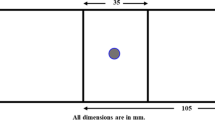Abstract
In this study, the influence of production-related gaps on the shear tension strength and fatigue performance was investigated for resistance spot welded TRIP steel HCT690, Furthermore, the local strain distribution in shear tension test was calculated by the digital image correlation technique (DIG), The static shear tension strength was found to be almost independent of gaps up to 3 mm, The maximum local strain in the spot weld region however decreases depending on which sample side (deformed or undeformed) is considered, In addition, it has been ascertained that gaps of 3 mm lead to a significant drop in fatigue life compared to gap-free shear tension samples, This fact could be attributed to decreased stiffness, higher transverse vibration and higher rotation (0) between the sheets as well as increased local stress calculated by 2-dimensional FE simulation.
Similar content being viewed by others
References
Ross E.: Investigations into material specific failure mechanisms of spot welded joints during crash and fatigue situations, AiF-Project DVS-No.: 04.038/IGF-Nr.: 14.927 N, 2008 (in German).
Hou W. and Kelley S.C.: Collapse force prediction for AHSS gapped RSW Joints, Sheet Metal Welding Conference XIII, paper 1–2, American Welding Society Detroit Section, 2008.
Keitel S. and Wesling V: Investigation into the spot weldabilty of modern high and ultra high strength steel sheets, AiF-Project DVS-No.: 04.025/IGF-Nr.: 12.618 N, 2002 (in German).
Zhang J. and Murakawa H.: FEM Simulation of the spot welding process (Report II), Effect of initial gap and electrode-type on nugget formation and expulsion, Transactions of JWRI, 1998, vol. 27, no. 2, pp. 73–79.
Adib H., Jeong J. and Pluvinage G.: Three-dimensional finite element analysis of tensile-shear spot-welded joints in tensile and compressive loading conditions, 2004, vol. 36, no. 4, pp. 353–364.
Ertas A.H., Yilmaz Y. and Baykara C.:An investigation of the effect of the gap values between the overlap portions of the spot-welded pieces on fatigue life, Proceedings of the Institution of Mechanical Engineers, Part C: Journal of Mechanical Engineering Science, 2008, vol. 222, no. 6, pp. 881–890.
Zehsatz M. and Hansanifard S.: Investigation gap effects in fatigue life of spot welded joints, 16th European Conference on Fracture, edited by E.-E. Gdoutos, Alexandroupolis, Greece, 2006.
Sun X, Stephens E.V. and Khaleel M.A.: Effects of fusion zone size and failure mode on peak load and energy absorption of advanced high strength steel spot welds under lap shear loading conditions, Engineering Failure Analysis, 2008, vol. 15,no. 4, pp. 356–367.
Pouranvari M., Asgari H.R., Mosavizadch S.M., Marashi PH. and Goodarzi M.: Effect of weld nugget size on overload failure mode of resistance spot welds, Science and Technology of Welding & Joining, 2007, vol. 12, no. 3, pp. 217–225.
Overbeeke J.L and Draisma J.: Fatigue characteristics of heavy-duty spot welded lap joints, Metal Construction and British Welding Journal, 1974, vol. 6, no. 7, pp. 213–219.
Lorenz S. and Kannengiesser T.: Strain field measurement on laser-GMA-hybrid welded joints, Proceedings of the JOM-155th International Conference on the Joining of Materials, Helsingor-Denmark, 2009.
Gould J.E, Khurana S.P. and Li T.: Predictions of microstructures when welding automotive advanced high-strength steels — A combination of thermal and microstructural modeling can be used to estimate performance of welds in advanced high-strength steels, Welding Journal, 2006, vol. 85, no. 5, pp. 111–116.
Zhang H. and Senkara J: Resistance welding: fundamentals and applications, 2006, Boca Raton, FL, Taylor & Frances.
Specification for automotive weld quality — Resistance spot welding of steel, AWS D8.1 M:2007, An American National Standard, American Welding Society, Miami, FL. 2007.
Preβ H. and Simon G.: Influence of transverse vibrations on the fatigue behaviour of spot welded joints, Schweiβen und Schneiden, 1991, vol. 43, no. 1, pp. 9–13 (in German).
Wang G. and Barkey M.E.: Investigating the spot weld fatigue crack growth process using X-ray imaging, Welding Journal, 2006, vol. 85, no. 4, pp. 84–90.
Pan N. and Sheppard S.D.: Stress intensity factors in spot welds, Engineering Fracture Mechanics, 2003, vol. 70, no. 5, pp. 671–684.
D. Radaj: Fatigue strength: fundamentals for engineers, Springer, Berlin; edition 3, 2009 (in German).
Davidson J.A. and Imhof E.J.: A fracture-mechanics and system-stiffness approach to fatigue performance of spot-welded sheet steels, SAE International Congress and Exposition, Detroit, Michigan, USA. February 1983.
Choi B, Joo D.H. and Song S.H.: Observation and prediction of fatigue behaviour of spot welded joints with triple thin steel plates under tensile-shear loading, International Journal of Fatigue, April 2007, vol. 29, no. 4, pp. 620–627.
Lindgren C, Sperle J.O. and Jonsson M.: Fatigue strength of spot welded beams in high strength steels, Doc. IIW-1267, Welding in the Word, 1996, vol. 37, no. 1, pp. 90–104.
DIN EN ISO 18265:2003 Metallic materials — Conversion of hardness values (ISO 18265:2003), 2003.
Author information
Authors and Affiliations
Corresponding author
Rights and permissions
About this article
Cite this article
Brauser, S., Pepke, LA., Weber, G. et al. Influence of Production-Related Gaps on Strength Properties and Deformation Behaviour of Spot Welded Trip Steel HCT690T. Weld World 56, 115–125 (2012). https://doi.org/10.1007/BF03321342
Published:
Issue Date:
DOI: https://doi.org/10.1007/BF03321342



